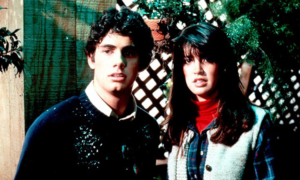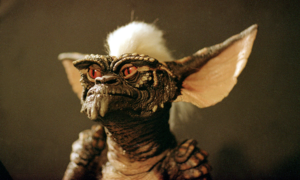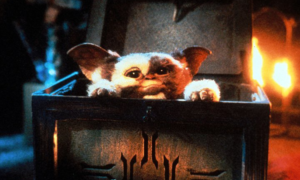“It was kind of like a huge practical joke played on the audience. For 45 minutes they were lulled into thinking it was ET 2, then suddenly when everyone was relaxed it freaked them out… or rather, Joe Dante freaked them out!”
Zach Galligan is talking about the ingeniously deceptive concept of Gremlins, in which he played Billy Peltzer, the shy teen who goes up against the terrorising offspring of his impossibly cute Mogwai (meaning ‘devil monster’ in Cantonese) Christmas present ‘Gizmo’ in the comedy classic that is indeed one half a cuddly, delightfully festive caper and the other a devilishly twisted creature feature.
“Nowadays, people kind of enjoy that subversive sensibility, when at the time it was like ‘what is this? This is just wrong! I thought I was coming to see a fluffy cute creature movie!’” continues Galligan.
It all gestated (quite literally) in Chris Columbus’ New York loft. The young, struggling scribe, who would go on to write the screenplay for enjoyably energetic Eighties teen adventure The Goonies and direct the first two Home Alone and Harry Potter outings, needed to prove himself, and was inspired by the unnerving sounds of cavenging rodents that plagued his attic late at night. Penning a spec script to prove his ability, the resulting concept landed on the lap of Steven Spielberg, who quickly realised its motion picture potential and passed it on to pal Joe Dante, who had a modest hit a couple of years earlier with horror comedy The Howling.
With that film’s producer, Michael Finnell (who was also involved with hit parody Airplane!) on board, Spielberg took the project to Warner Bros and co- produced the film as Amblin Entertainment’s third feature, following the tremendous success of ET. After some considerable script revisions to tone down some of the more horrific elements in the story (more of which later), attention turned to casting the two likeable teenage leads that would help humanise proceedings.
Fresh off the sleeper success of coming-of-age comedy Fast Times At Ridgemont High, Phoebe Cates was cast as sweet-natured love interest Kate Beringer, while the search was on for someone to embody geeky teen Billy. In a part that was auditioned by practically every major young acting talent at the time – including, but not limited to Kevin Bacon, Judd Nelson, Emilio Estevez and Karate Kid Ralph Macchio – newcomer Galligan landed the lead thanks to some crucial chemistry with Cates.
“It was actually one of the easier parts I ever got,” recalls Galligan. “We only read one scene where we’re on a date and at the end, I don’t know why I did it, but I put my head on her shoulder… then a day or two later I got the part. When I finally did the movie I asked Joe Dante what I did to land it, and he said, ‘Steven saw the tape, and when you put your head on Phoebe’s shoulder he said ‘Oh my God, the guy is in love with her already – I don’t need to see anymore!’”

It was a role that the then 19-year old could also relate to. “I was the guy at the sixth grade dance who would go up and ask pretty girls to dance, and they would reject me and go with the cute guy,” reveals Galligan. “I certainly knew what it was like to be kind of the loner who collected comic-books and did drawings – I totally identified!”
Perhaps something the actor took longer to identify with was the daunting prospect of playing the lead in a major Spielberg production. “I was too young and stupid to realise, but once I got a tour of the sets, looked at the schedule and realised I was working 71 out of 75 shooting days, I thought to myself, ‘Holy cow, this whole movie is just me and Gizmo!’ Then I would have mini panic attacks in the mornings: I’d wake up and realise I have this day ahead of me, then freeze in bed and think, ‘There’s no way I can do this!’ But by the time I’d woken up, taken a shower and gotten dressed I had calmed down. Then, by the time I got into work I went in with confidence.”
It certainly helped that the actors playing Galligan’s parents, the late country singer Hoyt Axton and character actress Frances Lee McCain, weren’t major stars. “There were a lot of great actors, but there wasn’t really a huge intimidating star,” considers Galligan. “[Randall] was supposed to be played by Dick Van Dyke, but he had a scheduling conflict. If Dick Van Dyke was my dad I probably would have lost my shit, because I grew up watching Mary Poppins! I actually think it turned out a lot better with someone like Hoyt who had an ‘Oh shirks, I’m just another guy from Oklahoma’ kind of vibe about him.”
A less loveable character was larger-than-life town scrooge Mrs Deagle, played by soft-spoken, Southern- toned actress Polly Holliday. “When I first got the script it said ‘Mrs Deagle: the meanest woman in town!’” recalls the actress who embodied the ice-cold creation. “It was sort of based on Margaret Hamilton in The Wizard Of Oz, and that’s sort of where the character was coming from… you wouldn’t want to spend time with her; she was just an unpleasant woman.”
The similarities with the original Wicked Witch of the West continued all the way to the character’s memorable demise courtesy of a malfunctioning stairlift that thrusts her through her top story window, a sequence Holliday even had some creative input into. “I told Joe Dante, ‘Wouldn’t it be funny if I had on these little booties and you see my feet sticking out of the snow bank the way Margaret Hamilton was sticking out from underneath the house in The Wizard Of Oz?’ So he put it in there!”
If you thought Mrs Deagle was a force to be reckoned with, nothing prepared audiences for the real monsters of the show. “The directives for the Gremlins’ design were straightforward: ‘Make ’em real scary,’” says Oscar-winning FX maestro Chris Walas, who was tasked with creating the titular creatures whose design phrase altered as the production developed. “The original story was a straight horror tale, so the preliminary designs were more realistic,” he continues. “The Mogwai had to be cute and cuddly, [but] I wanted to make sure that once they turned to Gremlins the audience still felt the biological connection in the design. The Gremlins in many ways are the reverse of the Mogwai: where the Mogwai were soft and furry, the Gremlins were scaly and toothy. I always viewed them as two phases of childhood: the sweet, cute baby phase and the troublemaking, getting-into everything toddler phase.”

The original script differed considerably, with Gizmo actually turning into a Gremlin instead of giving birth to them. It was Spielberg who thought Gizmo was too cute a character for this to happen to, so the concept of two separate entities was designed, dramatically altering the tone of the film.
“All sorts of horrible things were supposed to be happening,” adds Galligan, “with the Gremlins becoming super violent and heads bouncing down the stairs… Spielberg got involved and said, ‘ We’re gonna put the breaks on that right now!’” Indeed, the decapitated head that the actor refers to was in fact supposed to be his on-screen mother, who loses it in a fight with the creatures. In addition to this, the Gremlins were originally intended to eat Billy’s faithful canine companion Barney and, in probably one of the most audacious unrealised sequences, the Gremlins attack a branch of McDonalds, discarding the burgers but eating the customers!
Toning down the on-screen onslaught didn’t reduce the amount of technical problems the production faced, however, particularly concerning the mechanics of our furry friend. “When it went well it was great, and when things broke down it meant there were tremendous delays,” reveals Galligan about Gizmo. “The springs would snap, we would recognise the sound of it breaking, and Chris Walas would come over, look at it and say, ‘Looks like about six or seven hours,’ so we would go off to Spielberg’s office and play videogames!”
Walas recalls the challenges he and his technical team faced with the ever-changing production. “There were a lot of intricate puppets in the show, and they weren’t just in a few scenes; they were in a lot of the movie, so there were invariably a lot of cables popping and radio control interference that plagued us,” he says. “The continual changes in the action also put the puppets through a lot of unplanned, spontaneous actions, which was a real strain on them, so maintenance was a huge ongoing job.”
Part of the challenge was keeping up with Dante’s enthusiastic creative spontaneity. “Once Joe saw what might be possible with the puppets, he really got creative with the gags. That worked fantastically for the film, but was a continual challenge for me and my crew to keep up with,” admits Walas.
Galligan recalls how Dante’s editing background (he co-edited his previous horror features Piranha and The Howling with Mark Goldblatt) aided the filmmaker with an extraordinary ability to envision the film as he shot it. “He was really fun to work with because he was always cutting the movie in his head, editing it as he went along,” he says. “So it was cool to work with someone who pretty much knew exactly what the movie looked like before he even shot it!”
Arguably one of the most memorable set pieces in the movie is the home invasion scene, where Mrs Peltzer goes to battle with the creatures in her kitchen using any means at her disposal, the home blender and microwave becoming particularly beneficial and leading to some truly gruesome moments.
“Even when we were doing it, we all thought the microwave gag might be a bit over the top,” reveals Walas about the eye-opening scene where a Gremlin explodes in the microwave. “We really didn’t think the shot would ever be in the movie, so we went whole hog on it… it was a lot of yuck, and the whole interior of the microwave was covered in the mess. The entire crew groaned horribly when we shot it!”
The scene in question was partially responsible for the creation of the PG-13 certificate, while US critic Leonard Maltin fiercely disapproved of the violence and mayhem caused by the Gremlins, landing him a tongue-in-cheek cameo in the satirised sequel where he repeats his criticisms and is subsequently attacked by the creatures as a result.
Gremlins also contained some classic non-violent comedic moments, particularly involving the malfunctioning of Peltzer senior’s inventions, usually at the expense of Peltzer Jr. “We only did two or three takes of the [orange juicer scene] because I literally had to get in the shower after each take… that thing blasted me with so much orange juice it would take ten minutes for them to comb the pulp out of my hair!” Galligan recalls. “The scene you see in the film is the last one shot. I’m trying to keep it together – it’s just too funny!”
Controversially, it was the lighter elements of Gremlins that were pushed during the ad campaign. One particular trailer focused entirely on Gizmo and completely overlooked the titular creatures in an attempt to plug a much softer film that would appeal to the family friendly likes of ET. But it looks like it wasn’t just the audience who were tricked into thinking this was a cute and cuddly comedy. “I must admit, when I read the script I thought it was going to be charming,” remembers Holliday. “So I was surprised it turned out to be so scary and horrible… you work on things and you never quite know.”

On 8 June 1984, Gremlins premiered in US cinemas on the same day as the equally comedy horror-themed Ghostbusters, ranking second behind that film in its first weekend and becoming the fourth-highest grossing film of that year. But perhaps most impressive is how Gremlins was tailored to appeal to a broader international audience, with Gizmo’s dialogue (voiced primarily by Howie Mandel) recorded in different languages that included jokes and cultural references specific to different countries.
This was also the beginning of the popular Eighties era of comedy horror, where earlier films like The Howling and later Tim Burton’s Beetlejuice masterfully blended genres to hilariously zany effect. But Gremlins stands out thanks to its picture-postcard setting and nostalgic admiration for old classic family movies like The Wizard Of Oz and Frank Capra’s It’s A Wonderful Life, a clip of which features early in the film.
“Behind the nasty mischief of the film lies a warm and heartfelt love of the subject matter,” considers Walas. “I think that’s something that audiences appreciate, and even love about the film. It also finds a perfect blend of horror and comedy, of cute and fuzzy as well as mean and nasty.”
“It was a horror movie, but it was full of funny things,” muses Holliday. “You knew you were watching a movie, and that the characters in it were sort of tongue-in- cheek. It was a charming movie in a way, and then utterly scary.”
For Galligan it was the timeless quality of the film that appealed to him, except for one minor detail, perhaps. “I remember thinking at the time that there wasn’t a lot that kind of identified it as an Eighties movie, and I think it holds up because it doesn’t have a lot of the Eighties in it, except maybe my hair!” he laughs, referring to his dated on-screen curls.
A somewhat belated, satirical sequel followed in 1990 (see boxout), but in more recent times talk has turned to the inevitable remake. “I think it’s logical, but I haven’t seen anything, so it’s just a blank canvas at the moment,” continues Galligan. “I think if they’re smart they’ll at least do animatronics for Gizmo and maybe CGI on some of the other things.”
Walas is skeptical regarding the prospect of regurgitating Dante’s classic. “I’m not sure how an update would work, and more importantly I don’t know how feasible it is to hit that delicate balance of horror, comedy and heart that Joe managed,” he adds. “I know that CGI is the way things are done these days, but I think the fact that we used puppets allowed the audience to accept the fantasy level of the film. I’d hate to see the Gremlins redone as pure CGI, simply because I think they would lose a lot of their uniqueness.”
From its cozy Christmas town setting, groundbreaking puppetry, charming characterisation, magical comedic touches and subtle shift in tone to horror film territory, Gremlins remains an undisputable festive favourite 30 years on, and a formula that should remain pretty hard to duplicate.
Gremlins is available to purchase now on Blu-ray.
